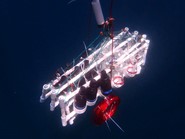The miniDOT Logger is a completely submersible instrument that logs dissolved oxygen and temperature measurements. The oxygen sensor is an optode that measures dissolved oxygen concentration in water through a fluorescence method. Data are recorded to an internal SD card. Operation of the miniDOT Logger such as setting the time and sample interval can be accomplished via the USB cable.

Studying the Effects of Climate Change on Marine Life
November 2, 2020
Stream-Aquifer Interactions with Coastal California Watershed
May 20, 2021miniDOT Loggers Solve the Case of the Disappearing Jellyfish
Project Details
- PRODUCT(S): miniDOT® Logger
- APPLICATION: Coastal / Ocean
- PARAMETER: Dissolved Oxygen, Temperature
- LOCATION: Palau
- ORGANIZATION: Coral Reef Research Foundation
- RECOGNITION:Jesse Wilson, Gerda Ucharm, and Michael Beman

Case Study Description
Jellyfish Lake in Palau is famous as a place to swim with jellyfish. This is possible because the jellyfish in this particular lake have reduced pneumatocysts, which means they are unable to sting people. Palau is located in the western part of the Pacific Ocean, near the Philippines. Due to its location, Palau is subject to the effects of El Niño, which significantly decreases aquatic nutrients for a short period of time.

Solving the Case of the Disappearing Jellyfish
The jellyfish population in Jellyfish Lake usually undergoes a massive decline during El Niños; it has even been known to disappear completely during the strongest ones, repopulating a year or two after. This is the result of the drastic environmental changes that occur during an El Niño, but researchers previously haven’t studied the exact changes that cause this loss of population.
The Coral Reef Foundation in Palau deployed three miniDOT Loggers shortly after the onset of the 2015/2016 El Niño. The goal of the study was to track changes in temperature and dissolved oxygen (DO) levels over time, giving the researchers a sense of the water column structure in the lake. They also aimed to use the changes in DO over light or dark periods of time to calculate photosynthesis and community respiration rates.
miniDOT® Loggers Deployed in Jellyfish Lake

The three miniDOT Loggers were deployed in Jellyfish Lake starting February 2016 and remained there for 12 months, with a sampling interval of 10 minutes.
Jesse Wilson, co-author of the study, said “I personally found the miniDOTs to be really easy to use. They were hardy (held up to our prolonged deployments in sulfidic environments) and required minimal maintenance with no visible sensor drift during our more than yearlong deployment. The data were also in an easy to use format and we were able to quickly launch into our modeling of the environment.”
Changes in Water Column Structure are Harmful to Jellyfish Population
 The study found that early-on physics, such as little rain and extremely warm temperatures, during an El Niño drove the changes in water column structure, which is likely also what caused the jellyfish population to collapse.
The study found that early-on physics, such as little rain and extremely warm temperatures, during an El Niño drove the changes in water column structure, which is likely also what caused the jellyfish population to collapse.
These changes drastically altered the depth of stratification and decreased DO levels in the lake. As external conditions returned to normal, biological oxygen cycling (photosynthesis, respiration) rates were observed to oscillate rather than immediately return to pre-El Niño levels. Similar pulses in biological activity are often seen when an ecosystem is undergoing changes. At the conclusion of the 12-month study, DO levels and stratification depth had returned to the levels they were observed at before El Niño.

